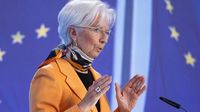The European Central Bank (ECB) has made headlines with its recent decision to cut interest rates for the seventh time, bringing them down to 2.25%, the lowest level since February 2023. This decision was made during a time of heightened economic uncertainty, particularly due to ongoing trade tensions stemming from the United States' tariff policies under former President Donald Trump.
Initially, during the ECB's meeting in March, the governors had considered pausing interest rate cuts, believing that inflation was nearing the target of 2%. However, just six weeks later, the economic landscape shifted dramatically, prompting the ECB to reverse its stance.
In a statement, the ECB noted, "It is likely that the adverse and volatile market response to trade tensions will lead to tighter financing conditions. These factors could further weigh on the economic outlook for the euro area." This acknowledgment of the deteriorating economic climate highlights the ECB's concerns over the potential impact of U.S. tariff increases on global growth.
As a direct consequence of the interest rate cut, mortgage rates in Spain have seen a significant decrease. New mortgages that previously carried an interest rate of 3.9% have now dropped to 2.9%. This reduction places Spain among the countries in the Eurozone with the most competitive mortgage rates, second only to Malta.
The average interest rate across the Eurozone currently stands at 3.3%, but Spain's proactive adjustments have made its mortgage offerings particularly attractive to consumers. This trend is expected to provide a much-needed boost to the housing market, as lower borrowing costs make purchasing homes more accessible.
Experts from Kelisto have estimated that the drastic fall in the reference interest rate could translate to an annual savings of approximately €1,500 for an average mortgage of €150,000. This represents a reduction of over 14%, with monthly payments decreasing from an average of €876 to €753 starting next month.
However, the implications of the ECB's decisions extend beyond just lower mortgage rates. Christine Lagarde, the President of the ECB, emphasized that the economic outlook has become clouded due to exceptional uncertainty, particularly related to trade tensions and geopolitical issues. She stated, "The outlook for growth has deteriorated owing to rising trade tensions," underscoring the ECB's commitment to adjusting its monetary policy in response to evolving economic conditions.
In addition to the interest rate cut, the ECB has also reduced the rates for weekly refinancing auctions to 2.4% and the credit facility to 2.65%, effective from April 23, 2025. These measures are part of the ECB's broader strategy to navigate the increasingly uncertain economic landscape.
The market's response to the ECB's actions has been mixed. While lower interest rates are generally seen as a positive development for borrowers, they may pose challenges for savers and those relying on interest income. Economists have pointed out that the current environment is particularly challenging for savers, as the continued decrease in interest rates may diminish the returns on savings accounts and fixed-income investments.
Looking ahead, analysts are divided on the potential trajectory of interest rates and the broader economic implications. Some foresee further cuts in the near future, particularly if the economic situation worsens, while others caution that rising inflation could prompt the ECB to reconsider its current approach.
As the ECB navigates these turbulent waters, the focus will be on how effectively it can stimulate economic activity while managing inflationary pressures. The upcoming months will be critical in determining whether the ECB's strategies will succeed in bolstering the euro area's economy amidst external pressures.
In summary, the ECB's recent interest rate cut is a significant move aimed at addressing the challenges posed by trade tensions and a weakening economic outlook. With mortgage rates dropping and potential savings for borrowers on the horizon, the impact of these changes will likely be felt across the Eurozone as consumers and businesses adapt to the new financial landscape.








